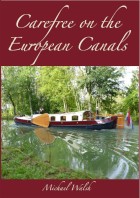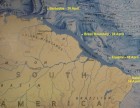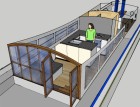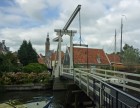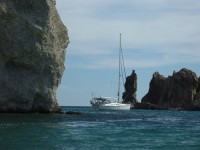Sequitur
Michael & Edi have headed out on a slow, thorough exploration of the globe.
| Vessel Name: | Sequitur and Zonder Zorg |
| Vessel Make/Model: | 2007 Hunter 49 and 1908 Wildschut Skûtsje |
| Hailing Port: | Vancouver, Canada |
| Crew: | Michael Walsh & Edi Gelin |
| About: | For our current location click, on Map & Tracking, then on the Google Earth logo. |
| Extra: | Follow us on Twitter: Follow @YachtSequitur |
| Social: |
13 January 2014
Another New Book Released
I am delighted to announce that my new book: Carefree on the European Canals is now in print and is available on Amazon.com, Amazon.ca [...]
26 April 2013
New Book Released
The proof copy of my new book arrived by courier today. I have approved it and it is now listed on Amazon for pre-order, with a publication date of 30 April. It is a rather large book at 680 pages in an 8.5 by 11 inch format with 315,000 words illustrated by over 2400 colour photos, charts and maps. [...]
24 April 2013
One Year Out of Brazil
One year ago today we sailed Sequitur out of Brazil after enduring more than six weeks in the least-friendly country that we had experienced during our three-year voyage. In the early evening of 24 April 2012 we crossed the line on the chart dividing Brazil from French Guyana and breathed a huge sigh [...]
27 October 2012 | Harlingen, Friesland
Planing a Metamorphosis
We have added a new post to the Zonder Zorg blog at: Planing a Metamorphosis.
29 September 2012 | Sneek, Netherlands
Onward to Friesland
We have arrived in Friesland and have added a new post to the skûtsje's blog at: Onward to Friesland
19 September 2012 | Hoorn, Netherlands
North From Aalsmeer
We have moved northward from Aalsmeer and I have added two new posts: Heading North From Aalsmeer and North From Amsterdam
13 September 2012 | Aalsmeer, Netherlands
Taking Possession
We are back in the Netherlands, and I have added some new posts to the ZonderZorg blog at: Taking Possession and Settling-In and Making Plans
20 August 2012 | Sequitur: St Augustine, USA - Michael & Edi: Vancouver, Canada - Nieuwe Zorg: Aalsmeer, Netherlands
Added a New Website
We have added a new website: Skûtsje ZonderZorg. Zonder zorg in Dutch means without worry. Our intention with the site is to provide a place to share some of the history, geography and culture of the skûtsje as we discover it. We will also use this place to document [...]
11 August 2012 | Sequitur: St Augustine, USA - Michael & Edi: Vancouver, Canada - Nieuwe Zorg: Aalsmeer, Netherlands
Still More Skûtsje History
We continued to attempt to track-down Douwe Albert Visser, who was the owner of Nieuwe Zorg in 1941 when she was re-registered. One of the problems we repeatedly encountered in our online searches was the effect of currently having Albert Visser and two Douwe Vissers as very competitive skûtsje racers, [...]
10 August 2012 | Sequitur: St Augustine, USA - Michael & Edi: Vancouver, Canada - Nieuwe Zorg: Aalsmeer, Netherlands
Some More Skûtsje History
While I was researching the history of Nieuwe Zorg, I finally found her first registration details obscured by an apparent typographical error in a transcribed online spreadsheet. She was listed as having been built in 1901 instead of 1908. I emailed the webmaster of the [...]
Return from Machu Picchu
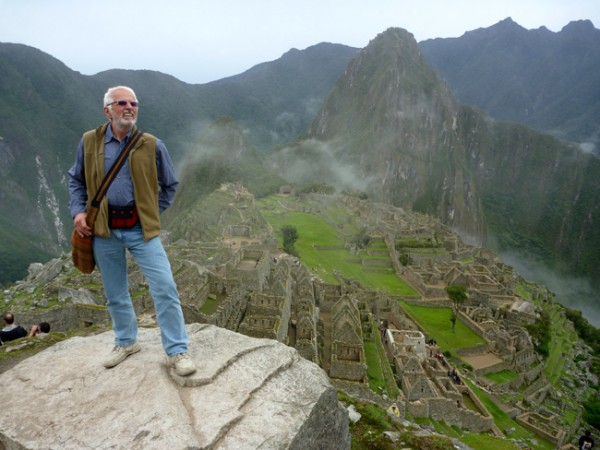
We freshened-up at the hotel and then went out in the rain to find a bite to eat. We had had such an excellent dinner at Indio Feliz the previous evening, and our hopes were high for another nice dining experience somewhere else in the town. We were badgered endlessly by menu-waving touts as we walked past empty and uninteresting restaurants.

We eventually settled on a small place with a handcrafted clay pizza oven in its back corner. All we wanted was a pizza and a cup of coffee; something to tide-us-over until dinner. Steaming mugs arrived with contents somewhat reminiscent of coffee, and the house pizza came nicely thin-crusted, but lacking pizzaz. The sauce was bland and the ingredients were sparse.
We wondered: With fresh ingredients so inexpensive why they had skimped on onions, peppers, tomatoes and other readily available local produce, why had they presented such a lacklustre meal? It is probably because most people come to Machu Picchu only once in their lives, the owner figured he didn't need to do anything to induce repeat business, not even to provide quality.

It continued to rain, so we took our filled, but unsatisfied bellies back to the hotel and napped. In the evening, we again walked out looking for a place to dine. We had read reviews raving about Chez Maggy: "A longtime favorite and branch of the legendary Chez Maggy in Cusco is a good, relaxed place"; and "Chez Maggy is the only restaurant we went to twice ... Fantastic!" It sounded good, so we decided to go.
We were cajoled, heckled and hassled at the entrance by a brash tout forcing a menu into our faces. I told the aggressor to back off; he was scaring us away from the place. I asked to be allowed to take our time reading the menu and to decide on our own whether we wanted to dine there. The menu read rather invitingly, and a nice selection of classic Italian pasta dishes caught our eye. We went in and picked a corner bench with our backs to the front stained-glass windows, and a view across the entire room. Ours was one of only three tables occupied.
The same surly fellow who had accosted us at the entrance was our waiter, and from him we ordered cervesas and a guacamole appetizer followed by fettuccini puttanesca for Edi and a chicken cannelloni for me. Twenty minutes later, after the newly arrived couple at the table next to us were served their guacamole, I asked the waiter about ours. He went to the kitchen and returned with it. Edi's pasta arrived shortly, but mine did not. After ten minutes, when my pasta had still not arrived, I walked up to the waiter at the kitchen servery and asked where my pasta was; I could see it plainly sitting there on the counter. A minute later he arrived at the table with my now tepid cannelloni. Our pastas were well past al dente, and the sauces were bland, thin and wet.

While we ate the sloppy pasta, an Inca couple, or one disguised as such, came in. He heated his drum head at the pizza oven, tuned it and they stood in a corner of the room and began making noise. The proprietor turned down the sound of the TV, which had been blaring a music show from above the bar. The uke, flute, drum and voice clamour continued for way too long, and eventually the TV was turned back up and the couple unsuccessfully polled the diners for money and attempted to sell their CDs.
Chez Maggy demonstrated to us many of the best ways for a restaurant to fail. However, it this remote corner of the world, flooded with nearly a million one-time-only visitors per year, they likely realized they need do very little to satisfy the hoards. The restaurant has been there since the 1970s, so their formula must be working. We went to bed disappointed that we had not returned to Indio Feliz.

Our train back to Cuzco was scheduled for 1600 on Wednesday, so we had many hours to fill before we needed to be at the station. After an early breakfast on Wednesday morning we set-out on a walk down the river along the road to Machu Picchu. In one place, the sheer cliff dropped directly into the Urubamba, and to traverse it, a half tunnel had been wrested from face, offering a bed for a one-lane road.

Along the way we passed some modern Inca stone carvers, splitting granite blocks for the ongoing building boom that seems everywhere in Aguas Calientes.

We saw a wonderful example of the regular fracture planes of the local granite. This characteristic would have been of great assistance to the ancient Inca stonemasons.

We met a local man on the road, and he went into the undergrowth and brought back an orchid, which he presented to Edi.

In the undergrowth at the sides of the road were many different flowers.

Peru is reputed to have 20% of all the plant species on the planet.

We saw red flowers ...

... and orange ones ...

... and a combination of both.

There were many of these bird-of-paradise-looking flowers ...

... some of them fruiting.

Wonderful flower blossoms everywhere.

... and butterflies to pollinate them.

We walked back into town and as we passed the rail siding on the main street, we saw men laboriously carting building materials from a just-arrived freight car. There is no road to Aguas Calientes, and everything comes in by rail.

Except for busses to Machu Picchu and the park service trucks on the riverside road, there are no vehicles. Above the river, the town is laid-out entirely with walking streets. Every thing is carried or pushed in a wonderful variety of wheelbarrows and one and two-wheeled carts.
Around mid-morning it began raining, and for shelter we walked into the covered marketplace, which borders the train station and serves the only passage from train to town. Its hundreds of stalls filter money from the tourists as they arrive. On Monday afternoon we had searched the entire market, and I had found a nice handmade alpaca shoulder bag, and we were still searching for a nice little candle holder for our dining table aboard Sequitur.

We found nothing to our liking, so we dodged the raindrops as well as possible, and made our way to Café Inkaterra, out along the river upstream of the town. It was wide open, but without a soul around, not even staff. We walked up the steps to the hotel and through its restful lobby to the dining room. It was a very tastefully decorated and peaceful place, but totally empty, except for one waiter folding napkins. We looked at the menu and decided that S/120 was more than we wanted to risk on the buffet lunch.
It was still raining heavily, so we walked back outside and along to a bench upholstered with reed cushions and set in the dry under the eaves. We sat watching the big rain drops glinting in an emerging sun, as they splashed on the jungle plants and flowers across the path. Edi continued with her sock knitting, and I continued reading "A Short Walk in the Hindu Kush", a book I had meant to read thirty-five years earlier on my way to climb in Afghanistan. Retirement now gives us opportunity to do the things we have previously set aside.

Toward 1300, the rain had stopped, and the sun was more regularly breaking through the thickly scattered clouds. We decided to revisit Indio Feliz for our lunch, and we were welcomed as long-lost friends. My quiche Lorraine entree on Monday evening had been so delicious, that we both decided to order a main course version of it for lunch. It came beautifully presented and accompanied by a large plate of sliced tomatoes, a bowl of sauce dijonnaise, a basket of homemade bread rolls and a huge terracotta dish of homemade butter. Everything was delicious, including the huge steaming mugs of coffee.

I told Patrick that this was the best quiche Lorraine I have had since one in Nancy many years ago. His eyes lit-up and he grinned broadly; he told me he was born in Nancy and that his cooking was influenced by the cuisine of that region of France. I told him I had lived just north of there in 1966 and 67, when I was serving with NATO. After lunch Patrick brought us huge snifters of Cognac to wish us fair winds on the continuation of Sequitur's voyage.
What a dramatic contrast there is between this restaurant and the others we experienced in Aguas Calientes. Indio Felize is a true oasis in a culinary desert. They serve large portions of delicious food, the atmosphere is warm and welcoming, and the many staff members we saw were all jovial, cordial and very professional. On the three occasions we were there, the place was busy, while the other restaurants in town begged for customers.

We walked back to the hotel to retrieve our bags from storage, and again we were heckled as we passed each restaurant. Most were empty, or nearly so; the owners simply didn't understand.

There were many people sitting around, apparently waiting for the afternoon trains back to Ollantaytambo or Cuzco. By their looks and dress, they appeared to come from all over the world, and by their shape, one couple was most likely from the United States. They were certainly not fending-off imminent starvation with their ice cream cones. We were harassed by stall-keepers as we made our way to the train station through the market and its repetitious selection of the same mass-produced tourist trash. Here again, the owners simply didn't understand.

Aboard the train, we settled-in across from a Japanese couple from Yokohama. Shortly after our 1600 departure, meal service began. Thankfully it was a light snack; we were still rather stuffed from our wonderful lunch. The menu read very invitingly, and because of our continuing thirst with the high altitude, we ordered cervesas, and were delighted to see that Peru Rail isn't gouging its captive audience; the cost was S/6 per bottle.

The snack was a very nicely presented assortment of regionally inspired tid-bits and taste experiences.

While we ate, we enjoyed the passing scene out the windows as we re-ascended the Urubamba Valley. There were many Inca agricultural terraces on the river banks and the slopes above them. We passed a suspension bridge, which led from a corral that appeared to be a staging area for the trail leading down the other side of the river.

We left the Rio Urubamba and entered the canyon of the Rio Huarocondo. Shortly after we began the ascent, the sun set and it quickly became dark. With no more entertainment from the passing scene through the windows, the staff offered us some of their own. A vividly-dressed and masked wild man danced through the car in an apparently traditional Inca ritual.

And then the car hostess let her hair down and started modelling some superbly crafted baby alpaca clothing.

Her male counterpart alternated with her and did his strut of the runway wearing more wonderful baby alpaca apparel.

The colours and styles were outstanding.

We were tempted into buying a couple of pieces each, when after the half-hour modelling session, they announced that the items were all available for purchase onboard. I chose this sweater plus a wonderful coral red one with cable knit patterns. There was no cellular connection for the credit card machine, so I had to wait until near the end of the trip to effect the payment.

The sweater that Edi wanted was too small, but the hostess said they could radio ahead to the station and have a larger one waiting there for our arrival. Someone else had already bought the scarf she wanted, so another was arranged for our arrival at the Poroy station. The fit was perfect, and Edi settled the account through a portable machine on the platform.
We were the last passengers to walk through the station and into the guarded compound outside its front, where we were approached by a taxi driver holding up his ID and license. Suspecting that we were his last prospects, we negotiated a very good fare down to Cuzco and to our hotel.

We were welcomed back at the Rumi Punka, where we needed no registration formalities; we were simply given a key, which let us into a huge room in the new section of the hotel, with a king bed and very large, modern bathroom. We unpacked, and I laid-out my newly acquired baby alpaca sweaters, two from the train and one acquired from a shop in Cuzco on the weekend.
Our minds and souls were so filled with our adventures of the previous few days, and our bellies were still filled with the wonderful food from Indio Feliz and the train, that we felt like nothing else but lying in bed with the BBC news looping on the TV until we bored of it and went to sleep.

Our room looked down into the courtyard and across it to the wing which houses the lounge and dining room. On Thursday morning we had a leisurely breakfast from the buffet, and then set out on foot to continue our exploration of Cuzco.

We walked again up to Plaza San Blas, looking in all the shops along the way for an alpaca scarf to compliment my coral red sweater. Most of the scarves we saw were coarse and rather garishly coloured. Along the way we enjoyed looking at the Inca walls, which are scattered through much of the city and incorporated into the newer buildings, many of which date to the beginnings of the Spanish colonial era nearly half a millennium ago.

The exacting stone-cutting of the Incas fascinated us. Large blocks of half a meter, a metre and more in size were carved with their compound curves and angles matching the adjacent blocks with such precision that there is no room even a sheet of paper between stones weighing many tones each.

We worked our way down the narrow streets back toward the centre of town, passing along the way many traditionally-dressed women, some leading llamas, others carrying loads on their backs, probably headed to the market to set-up.

As we neared the centre of town, in an area around the four and five star hotels, we found shops with finer baby alpaca scarves, but saw none that would complement my sweater. After nearly six hours of nosing around the stock of a hundred or more shops, we resigned ourselves to buying the scarf from Lima's Inca Market or a boutique in Miraflores when we get back down to the coast, or from the Peruvian shop on Vancouver's Granville Island when next we return to Canada.

We were hungry, and in desperation we had a bland and unexciting meal in one of the overpriced restaurants on the periphery of Place de Armas. The best we could say of it was that it filled the void. We walked back to the hotel, passing along the way more traditionally-dressed Inca women as well as reminders of the Catholic demolition of the magnificent Inca structures.
Our Friday morning flight back down to the coast went smoothly, after a delay as the airline apparently amalgamated our partly filled 0940 flight with the next one at 1100. We easily found a licensed taxi within the Lima airport's security compound, and negotiated an uneventful S/25 ride to La Punta.
After a visit to the mercado for fresh produce for dinner and to the bakery for bread, we took a launch back out to Sequitur in the mooring field of the Yacht Club Peruano. All was well aboard, the solar panels had brought the batteries back up to 100% and the Bolaseca dehumidification crystals had worked well, and had kept the boat dry and fresh-smelling. It was great to be home again.

